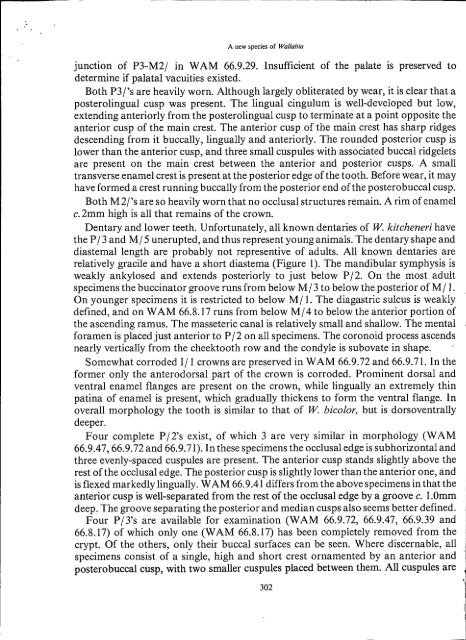a new species of wallabia - Western Australian Museum
a new species of wallabia - Western Australian Museum
a new species of wallabia - Western Australian Museum
You also want an ePaper? Increase the reach of your titles
YUMPU automatically turns print PDFs into web optimized ePapers that Google loves.
__I<br />
A <strong>new</strong> <strong>species</strong> <strong>of</strong> Wallabia<br />
junction <strong>of</strong> P3-M2j in WAM 66.9.29. Insufficient <strong>of</strong> the palate is preserved to<br />
determine if palatal vacuities existed.<br />
Both P3/,s are heavily worn. Although largely obliterated by wear, it is clear that a<br />
posterolingual cusp was present. The lingual cingulum is well-developed but low,<br />
extending anteriorly from the posterolingual cusp to terminate at a point opposite the<br />
anterior cusp <strong>of</strong> the main crest. The anterior cusp <strong>of</strong> the main crest has sharp ridges<br />
descending from it buccally, lingually and anteriorly. The rounded posterior cusp is<br />
lower than the anterior cusp, and three small cuspules with associated buccal ridgelets<br />
are present on the main crest between the anterior and posterior cusps. A small<br />
transverse enamel crest is present at the posterior edge <strong>of</strong>the tooth. Before wear, it may<br />
have formed a crest running buccally from the posterior end <strong>of</strong>the posterobuccal cusp.<br />
Both M2/'s are so heavily worn that no occlusal structures remain. A rim <strong>of</strong>enamel<br />
c. 2mm high is all that remains <strong>of</strong> the crown.<br />
Dentary and lower teeth. Unfortunately, all known dentaries <strong>of</strong> W. kitcheneri have<br />
the P j 3 and Mj 5 unerupted, and thus represent young animals. The dentary shape and<br />
diastemal length are probably not representive <strong>of</strong> adults. All known dentaries are<br />
relatively gracile and have a short diastema (Figure 1). The mandibular symphysis is<br />
weakly ankylosed and extends posteriorly to just below Pj2. On the most adult<br />
specimens the buccinator groove runs from below M j 3 to below the posterior <strong>of</strong> M j 1.<br />
On younger specimens it is restricted to below Mj 1. The diagastric sulcus is weakly<br />
defined, and on WAM 66.8.17 runs from below Mj4 to below the anterior portion <strong>of</strong><br />
the ascending ramus. The masseteric canal is relatively small and shallow. The mental<br />
foramen is placed just anterior to P j 2 on all specimens. The coronoid process ascends<br />
nearly vertically from the cheektooth row and the condyle is subovate in shape.<br />
Somewhat corroded Ij 1 crowns are preserved in WAM 66.9.72 and 66.9.71. In the<br />
former only the anterodorsal part <strong>of</strong> the crown is corroded. Prominent dorsal and<br />
ventral enamel flanges are present on the crown, while lingually an extremely thin<br />
patina <strong>of</strong> enamel is present, which gradually thickens to form the ventral flange. In<br />
overall morphology the tooth is similar to that <strong>of</strong> W. hicolor, but is dorsoventrally<br />
deeper.<br />
Four complete P/ 2's exist, <strong>of</strong> which 3 are very similar in morphology (WAM<br />
66.9.47,66.9.72 and 66.9.71). In these specimens the occlusal edge is subhorizontal and<br />
three evenly-spaced cuspules are present. The anterior cusp stands slightly above the<br />
rest <strong>of</strong>the occlusal edge. The posterior cusp is slightly lower than the anterior one, and<br />
is flexed markedly lingually. WAM 66.9.41 differs from the above specimens in that the<br />
anterior cusp is well-separated from the rest <strong>of</strong> the occlusal edge by a groove c. 1.Omm<br />
deep. The groove separating the posterior and median cusps also seems better defined.<br />
Four Pj3's are available for examination (WAM 66.9.72, 66.9.47, 66.9.39 and<br />
66.8.17) <strong>of</strong> which only one (WAM 66.8.17) has been completely removed from the<br />
crypt. Of the others, only their buccal surfaces can be seen. Where discernable, all<br />
specimens consist <strong>of</strong> a single, high and short crest ornamented by an anterior and<br />
posterobuccal cusp, with two smaller cuspules placed between them. All cuspules are i<br />
302 '1<br />
I)
















